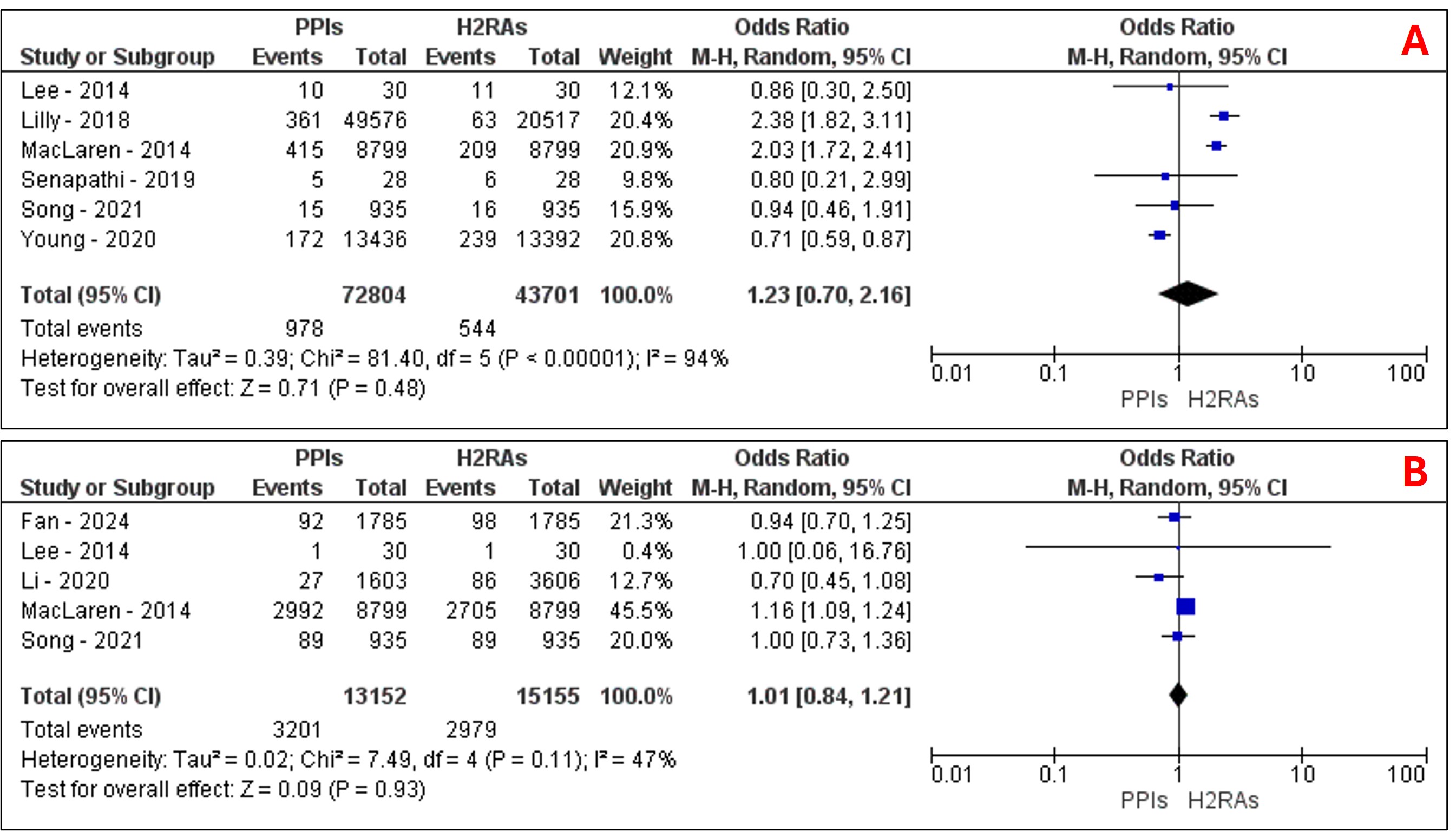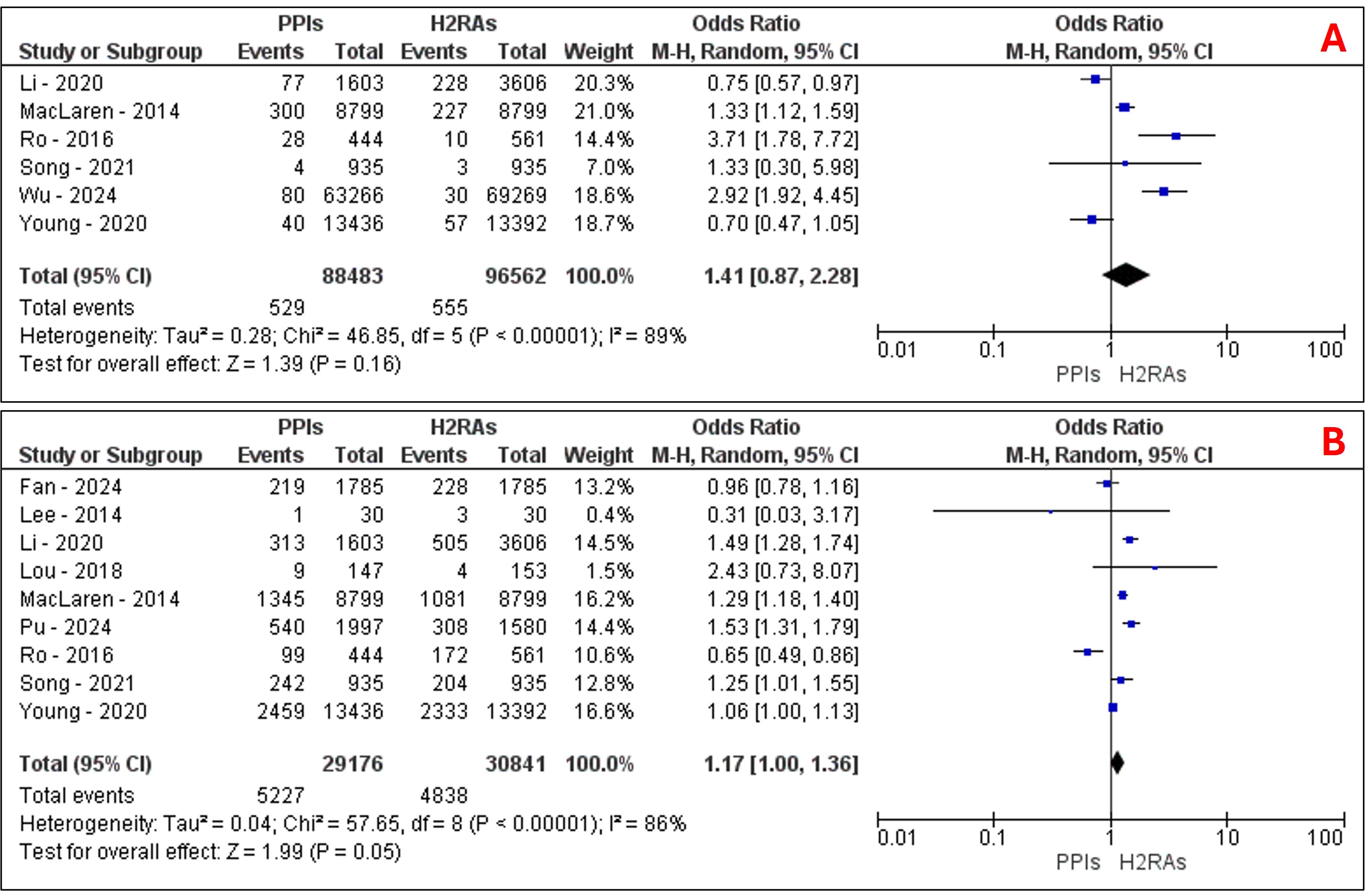Sunday Poster Session
Category: GI Bleeding
P0943 - Efficacy and Safety of Proton Pump Inhibitors versus Histamine-2 Receptor Antagonists for Stress Ulcer Prophylaxis in Critically Ill Patients
Sunday, October 26, 2025
3:30 PM - 7:00 PM PDT
Location: Exhibit Hall

Priya Kumari Maheshwari, MD (she/her/hers)
University of Central Florida, HCA Healthcare GME
Pensacola, FL
Presenting Author(s)
Priya Kumari Maheshwari, MD1, Dheeraj Kumar Maheshwari, MBBS2, Mayank Rampal, MD3, Tekchand Maheshwari, MBBS4, Ali Tariq, MD5, Anil Harrison, MD6
1University of Central Florida, HCA Healthcare GME, Pensacola, FL; 2Liaquat University of Medical and Health Science, Pensacola, FL; 3UCF/HCA Florida West Hospital, Pensacola, FL; 4Isra University, Hyderabad, Sindh, Pakistan; 5HCA FLORIDA WEST HOSPITAL, Pensacola, FL; 6Midwestern University, Glendale, AZ
Introduction: Stress ulcer prophylaxis (SUP) is critical in preventing gastrointestinal (GI) bleeding in critically ill patients, who are vulnerable to stress-related mucosal damage. Proton pump inhibitors (PPIs) and histamine-2 receptor antagonists (H2RAs) are commonly used, but their comparative efficacy and safety remain debated. This systematic review and meta-analysis evaluates PPIs vs. H2RAs in critically ill adults, focusing on GI bleeding prevention and associated risks.
Methods: We included randomized controlled trials (RCTs) and observational studies published between January 2014 and March 2025 comparing PPIs vs. H2RAs in critically ill adults requiring SUP were included. Eligible studies reported the outcomes of GI bleeding, mortality, pneumonia, and CDI. A comprehensive search across major databases was conducted in March 2025. Risk of bias was assessed using Cochrane Risk of Bias Tool (RoB 1) for RCTs and the Newcastle-Ottawa Scale for observational studies. Data extraction followed PRISMA guidelines, and meta-analysis used random-effects models, with heterogeneity assessed via the I² statistic.
Results: The search yielded 6,354 studies, and 12 studies met the inclusion criteria: 4 RCTs and 8 observational studies, involving 262,701 participants.
Discussion: While PPIs are often preferred for SUP, this analysis indicates no significant advantage over H2RAs in reducing GI bleeding. Moreover, their use may be associated with increased risks of CDI and mortality, warranting cautious, individualized use in critically ill patients.

Figure: Figure 1A: Forest Plot - Odds Ratios (OR) of GI Bleed Based on PPIs and H2RAs. Figure 1B: Forest Plot - Odds Ratios (OR) of Pneumonia Based on PPIs and H2RAs

Figure: Figure 2A: Forest Plot - Odds Ratios (OR) of CDI Based on PPIs and H2RAs. Figure 2B: Forest Plot - Odds Ratios (OR) of Mortality Based on PPIs and H2RAs
Disclosures:
Priya Kumari Maheshwari indicated no relevant financial relationships.
Dheeraj Kumar Maheshwari indicated no relevant financial relationships.
Mayank Rampal indicated no relevant financial relationships.
Tekchand Maheshwari indicated no relevant financial relationships.
Ali Tariq indicated no relevant financial relationships.
Anil Harrison indicated no relevant financial relationships.
Priya Kumari Maheshwari, MD1, Dheeraj Kumar Maheshwari, MBBS2, Mayank Rampal, MD3, Tekchand Maheshwari, MBBS4, Ali Tariq, MD5, Anil Harrison, MD6. P0943 - Efficacy and Safety of Proton Pump Inhibitors versus Histamine-2 Receptor Antagonists for Stress Ulcer Prophylaxis in Critically Ill Patients, ACG 2025 Annual Scientific Meeting Abstracts. Phoenix, AZ: American College of Gastroenterology.
1University of Central Florida, HCA Healthcare GME, Pensacola, FL; 2Liaquat University of Medical and Health Science, Pensacola, FL; 3UCF/HCA Florida West Hospital, Pensacola, FL; 4Isra University, Hyderabad, Sindh, Pakistan; 5HCA FLORIDA WEST HOSPITAL, Pensacola, FL; 6Midwestern University, Glendale, AZ
Introduction: Stress ulcer prophylaxis (SUP) is critical in preventing gastrointestinal (GI) bleeding in critically ill patients, who are vulnerable to stress-related mucosal damage. Proton pump inhibitors (PPIs) and histamine-2 receptor antagonists (H2RAs) are commonly used, but their comparative efficacy and safety remain debated. This systematic review and meta-analysis evaluates PPIs vs. H2RAs in critically ill adults, focusing on GI bleeding prevention and associated risks.
Methods: We included randomized controlled trials (RCTs) and observational studies published between January 2014 and March 2025 comparing PPIs vs. H2RAs in critically ill adults requiring SUP were included. Eligible studies reported the outcomes of GI bleeding, mortality, pneumonia, and CDI. A comprehensive search across major databases was conducted in March 2025. Risk of bias was assessed using Cochrane Risk of Bias Tool (RoB 1) for RCTs and the Newcastle-Ottawa Scale for observational studies. Data extraction followed PRISMA guidelines, and meta-analysis used random-effects models, with heterogeneity assessed via the I² statistic.
Results: The search yielded 6,354 studies, and 12 studies met the inclusion criteria: 4 RCTs and 8 observational studies, involving 262,701 participants.
- GI Bleeding: 6 studies (Figure 1A) reported that PPIs (n = 72,804) were not significantly more effective than H2RAs (n = 43,701) in preventing GI bleeding risk (OR: 1.23, 95% CI: 0.70–2.16, I² = 94%).
- Pneumonia: 5 studies (Figure 1B) reported that there was no statistically significant difference between PPIs (n = 13,152) and H2RAs (n = 15,155) in pneumonia risk (OR: 1.01, 95% CI: 0.84–1.21, I² = 47%).
- CDI: Across 6 studies (Figure 2A), PPIs (n = 88,483) compared to H2RAs (n = 96,562) were numerically associated with a high risk of CDI but not statistically significant (OR: 1.41, 95% CI: 0.87–2.28, I² = 89%).
- Mortality: In 9 studies (Figure 2B), patients receiving PPIs (n = 29,176) had a slightly higher mortality risk than those receiving H2RAs (n = 30,841) (OR: 1.17, 95% CI: 1.00–1.36, I² = 86%).
Discussion: While PPIs are often preferred for SUP, this analysis indicates no significant advantage over H2RAs in reducing GI bleeding. Moreover, their use may be associated with increased risks of CDI and mortality, warranting cautious, individualized use in critically ill patients.

Figure: Figure 1A: Forest Plot - Odds Ratios (OR) of GI Bleed Based on PPIs and H2RAs. Figure 1B: Forest Plot - Odds Ratios (OR) of Pneumonia Based on PPIs and H2RAs

Figure: Figure 2A: Forest Plot - Odds Ratios (OR) of CDI Based on PPIs and H2RAs. Figure 2B: Forest Plot - Odds Ratios (OR) of Mortality Based on PPIs and H2RAs
Disclosures:
Priya Kumari Maheshwari indicated no relevant financial relationships.
Dheeraj Kumar Maheshwari indicated no relevant financial relationships.
Mayank Rampal indicated no relevant financial relationships.
Tekchand Maheshwari indicated no relevant financial relationships.
Ali Tariq indicated no relevant financial relationships.
Anil Harrison indicated no relevant financial relationships.
Priya Kumari Maheshwari, MD1, Dheeraj Kumar Maheshwari, MBBS2, Mayank Rampal, MD3, Tekchand Maheshwari, MBBS4, Ali Tariq, MD5, Anil Harrison, MD6. P0943 - Efficacy and Safety of Proton Pump Inhibitors versus Histamine-2 Receptor Antagonists for Stress Ulcer Prophylaxis in Critically Ill Patients, ACG 2025 Annual Scientific Meeting Abstracts. Phoenix, AZ: American College of Gastroenterology.
